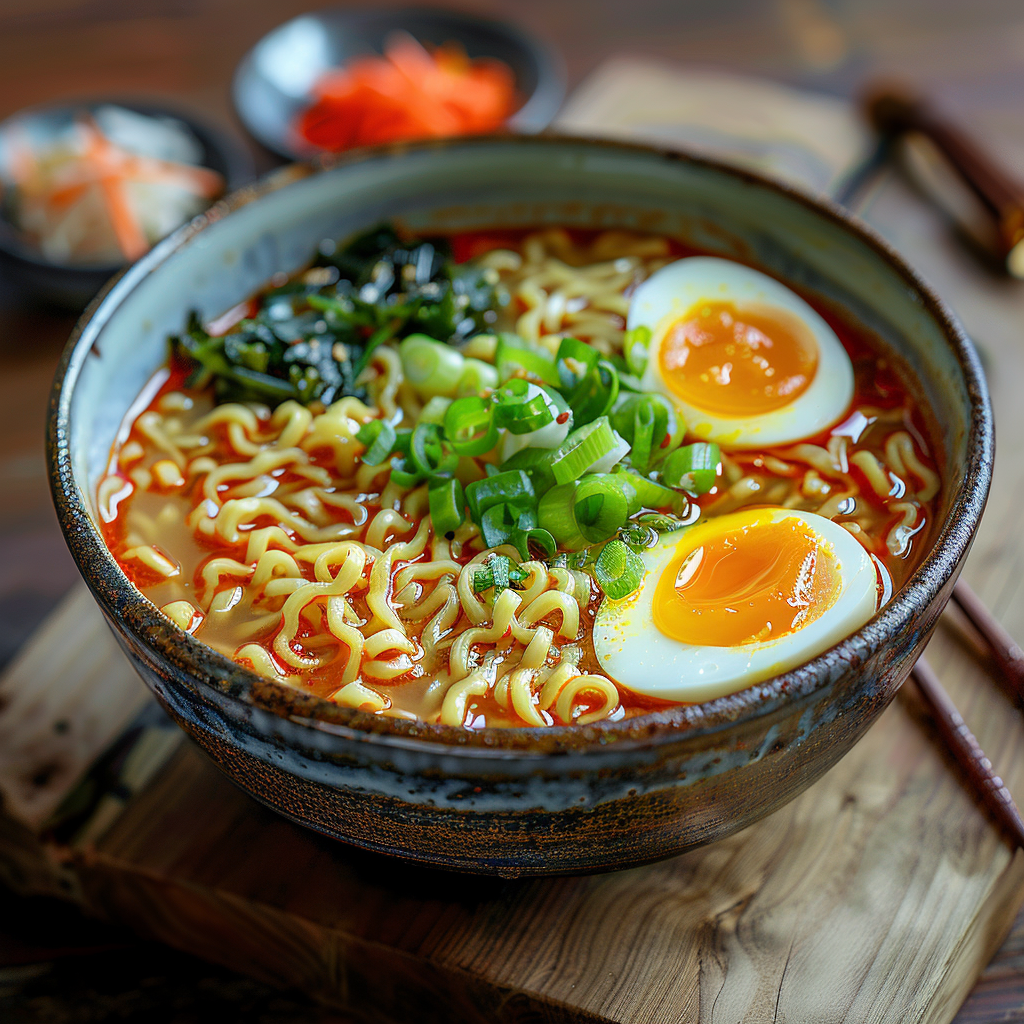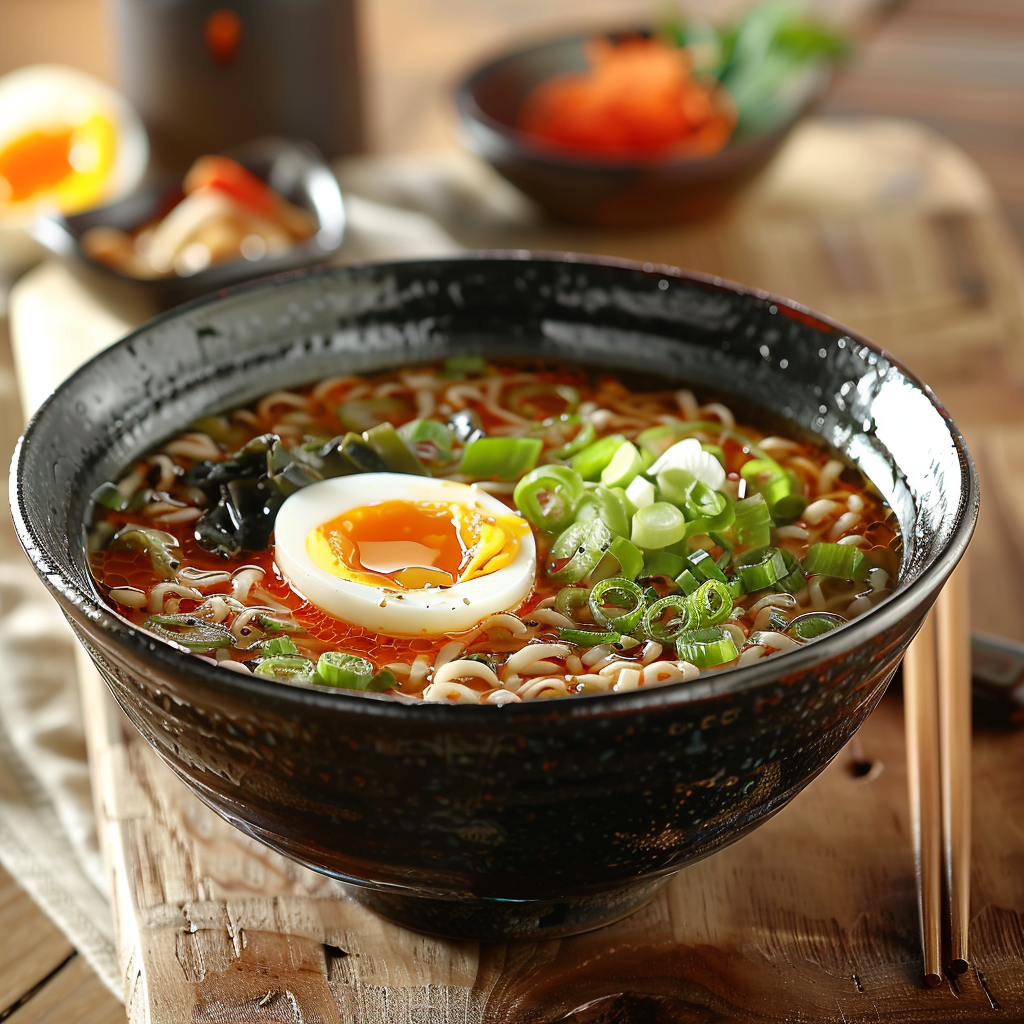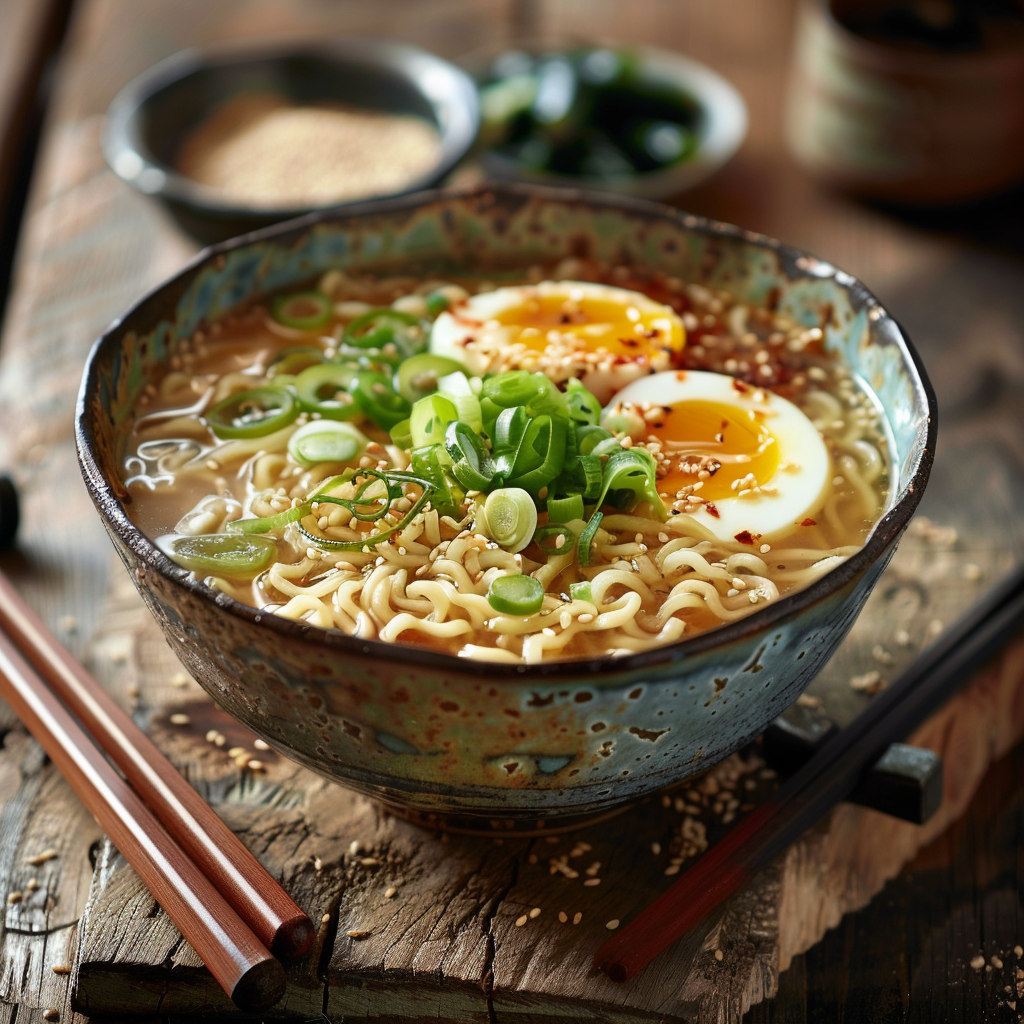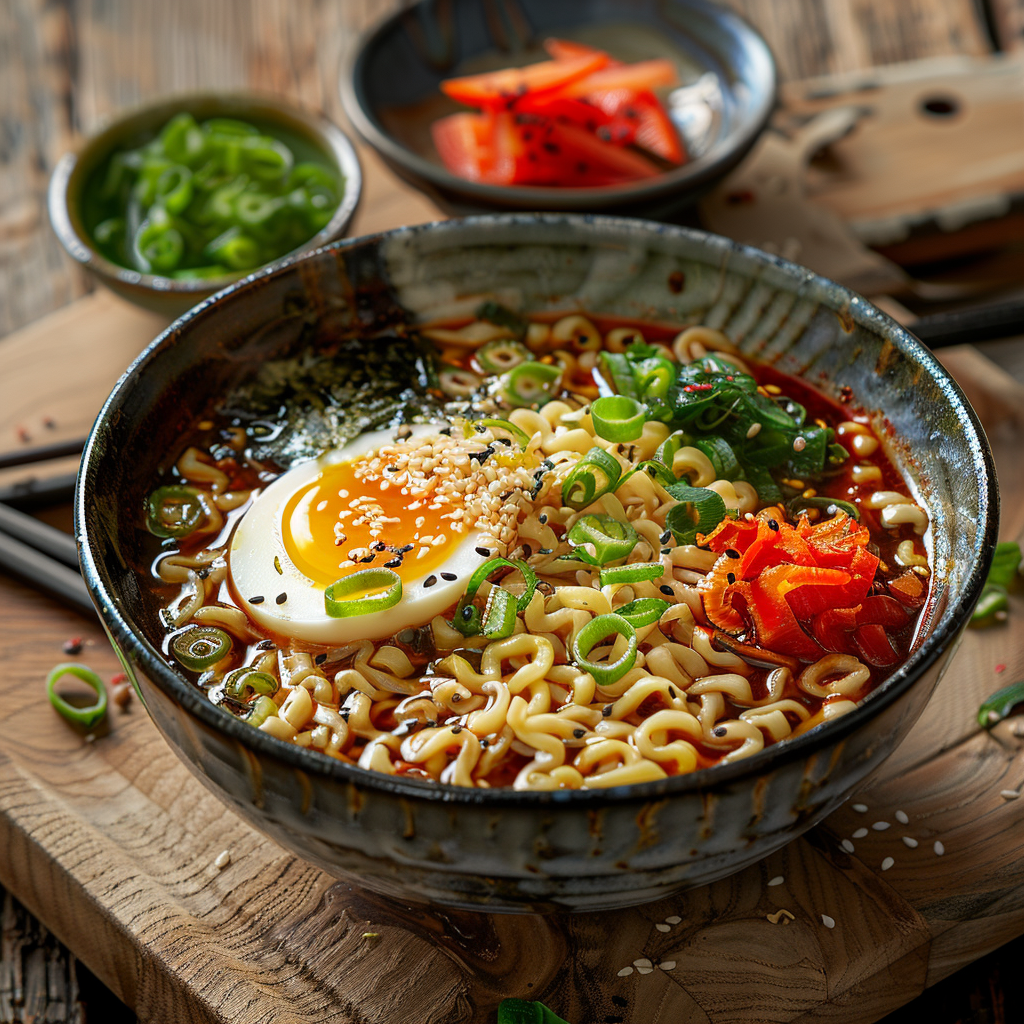
Why Japanese Ramen Noodle Soup with Egg is a Game-Changer
Picture this: it’s a chilly evening, and you’re craving something warm, comforting, and packed with flavor. That’s when I discovered the magic of Japanese Ramen Noodle Soup with Egg. This dish isn’t just food—it’s an experience. The first time I made it, my kitchen smelled like a cozy noodle shop in Tokyo. My family couldn’t stop raving about how rich the broth was and how perfectly soft the egg turned out. Trust me, once you try this recipe, you’ll want to make it again and again.
The Story Behind Japanese Ramen Noodle Soup with Egg
Ramen has a fascinating history. It originated in China but became a Japanese staple in the early 1900s. Over time, it evolved into countless regional variations, each with its own twist. From creamy tonkotsu to savory miso, ramen is more than just noodles in broth—it’s a cultural icon. My version of Japanese Ramen Noodle Soup with Egg blends classic techniques with simple ingredients, making it perfect for home cooks who want authenticity without spending hours in the kitchen.
Why You’ll Love This Recipe
Let’s talk about why this dish is so special. First, the flavors are bold yet balanced. The umami-packed broth pairs beautifully with tender noodles and a silky egg. Second, it’s surprisingly easy to make. With just a few pantry staples and fresh ingredients, you can whip up a bowl that tastes restaurant-quality. Plus, it’s versatile! You can customize it with toppings like green onions, seaweed, or even chili oil if you’re feeling adventurous.
When to Serve Japanese Ramen Noodle Soup with Egg
This dish is perfect for so many occasions. Need a quick weeknight dinner? Done. Hosting friends for a casual get-together? Impress them with your culinary skills. Feeling under the weather? A steaming bowl of Japanese Ramen Noodle Soup with Egg will soothe your soul. It’s also a great option for date night or even meal prep—yes, you can store it for later!
Ingredients
- 4 cups chicken or vegetable broth
- 2 tablespoons soy sauce
- 1 tablespoon miso paste
- 2 cloves garlic, minced
- 1 teaspoon grated ginger
- 2 packs of ramen noodles (discard seasoning packets)
- 4 large eggs
- 2 green onions, sliced
- 1 sheet nori (seaweed), cut into strips
- Optional: sesame seeds, chili oil, or cooked pork slices

Substitution Options
- Swap chicken broth for beef or mushroom broth for a different flavor profile.
- Use tamari instead of soy sauce for a gluten-free option.
- If you don’t have miso paste, add a dash of fish sauce for extra umami.
- Replace ramen noodles with soba or udon if preferred.
Step 1: Prepare the Broth
Start by heating your broth in a large pot over medium heat. Add soy sauce, miso paste, garlic, and ginger. Stir until everything dissolves, creating a fragrant base. The aroma of garlic and ginger will fill your kitchen, making everyone curious about what’s cooking. Pro tip: Taste the broth as you go. Adjust the seasoning to suit your preference—some like it saltier, while others prefer a milder flavor.
Step 2: Cook the Eggs
While the broth simmers, boil water in a small saucepan. Gently lower the eggs into the water and set a timer for 6 minutes. This timing gives you the perfect jammy yolk. Once done, transfer the eggs to an ice bath to stop the cooking process. Peel them carefully—you’ll see that gorgeous golden center. Chef’s tip: Crack the shells lightly before peeling; it makes the process easier.
Step 3: Cook the Noodles
In a separate pot, cook the ramen noodles according to package instructions. Drain them well and divide them between bowls. The noodles should be springy and chewy, not mushy. Pro tip: Don’t overcook the noodles, as they’ll continue to soften slightly in the hot broth.
Step 4: Assemble Your Bowl
Ladle the hot broth over the noodles. Slice the soft-boiled eggs in half and place them on top. Sprinkle with green onions, nori strips, and optional toppings like sesame seeds or chili oil. Take a moment to admire your creation—the vibrant colors and textures are almost too pretty to eat. Almost.
Timing
- Prep Time: 10 minutes
- Cooking Time: 20 minutes
- Total Time: 30 minutes
Chef’s Secret
For an extra layer of flavor, toast your garlic in a dry pan before adding it to the broth. This tiny step adds a nutty depth that elevates the entire dish.
Extra Info
Did you know that ramen shops in Japan often specialize in just one type of broth? Some focus on shoyu (soy sauce-based), while others master tonkotsu (pork bone broth). My recipe combines elements of both for a hybrid that’s easy to make at home.
Necessary Equipment
- Large pot
- Small saucepan
- Slotted spoon
- Knife and cutting board
- Bowls for serving
Storage
Japanese Ramen Noodle Soup with Egg can be stored in the fridge for up to three days. Keep the broth and noodles separate to prevent sogginess. Reheat the broth gently on the stove before combining it with the noodles. For the eggs, store them in an airtight container submerged in water to keep them fresh.
If you plan to freeze the broth, omit the miso paste, as it can separate when thawed. Freeze the broth in portion-sized containers for convenience. When ready to serve, defrost overnight in the fridge and reheat on low heat.
Leftover toppings like green onions and nori should be stored separately. They lose their freshness quickly when mixed with the broth, so add them only when serving.
Tips and Advice
- Use fresh ginger and garlic for maximum flavor.
- Don’t skip the ice bath for the eggs—it ensures they peel easily.
- Experiment with toppings to find your favorite combination.

Presentation Tips
- Serve the soup in wide, shallow bowls to showcase the ingredients.
- Garnish with a sprinkle of sesame seeds or chili flakes for color.
- Add a lime wedge on the side for a pop of brightness.
Healthier Alternative Recipes
Here are six ways to make this dish healthier:
- Zucchini Noodle Ramen: Swap ramen noodles for zucchini noodles to reduce carbs.
- Vegan Ramen: Use vegetable broth and skip the egg for a plant-based version.
- Low-Sodium Option: Use low-sodium broth and reduce the soy sauce.
- Protein-Packed Ramen: Add tofu, edamame, or shredded chicken for extra protein.
- Whole Grain Ramen: Choose whole wheat noodles for added fiber.
- Keto-Friendly Ramen: Replace noodles with spiralized daikon radish.
Mistake 1: Overcooking the Noodles
Overcooked noodles turn mushy and ruin the texture of your soup. This happens when you leave them in the boiling water too long or let them sit in the hot broth. To avoid this, cook the noodles al dente and serve them immediately after adding the broth. Pro tip: Set a timer to ensure precision.
Mistake 2: Skipping the Ice Bath for Eggs
Without an ice bath, the eggs continue to cook, resulting in a fully set yolk instead of the desired jammy texture. Always prepare the ice bath ahead of time and transfer the eggs promptly. Practical tip: Use a slotted spoon to handle the eggs safely.
Mistake 3: Using Stale Ingredients
Freshness matters! Old ginger or garlic can taste bitter and dull the overall flavor. Check expiration dates and opt for fresh produce whenever possible. Bonus tip: Store ginger in the freezer for longer shelf life.
FAQ
What makes Japanese Ramen Noodle Soup with Egg unique?
This dish stands out because of its rich, umami-packed broth and the creamy texture of the soft-boiled egg. Unlike instant ramen, homemade versions allow you to control the quality of ingredients and tailor the flavors to your liking.
Can I make this recipe vegetarian?
Absolutely! Swap chicken broth for vegetable broth and omit the egg or use a plant-based alternative. The result will still be delicious and satisfying.
How do I achieve the perfect soft-boiled egg?
Boil the eggs for exactly 6 minutes, then transfer them to an ice bath. This method ensures a runny yolk and firm whites every time.
What toppings work best with this dish?
Popular toppings include green onions, nori, sesame seeds, chili oil, and cooked pork slices. Feel free to experiment based on your preferences.
Can I freeze the broth?
Yes, but leave out the miso paste. Freeze the broth in airtight containers and add the paste when reheating.
Is this dish kid-friendly?
Definitely! Kids love the fun textures and mild flavors. You can adjust the seasoning to make it less salty if needed.
How long does the soup last in the fridge?
Stored properly, the soup can last up to three days. Keep the broth and noodles separate to maintain freshness.
Can I use instant ramen noodles?
Yes, but discard the seasoning packets and follow the recipe for the broth. Instant noodles cook faster, so adjust the timing accordingly.
What’s the best way to reheat leftovers?
Reheat the broth gently on the stove and combine it with freshly cooked noodles. Avoid microwaving, as it can alter the texture.
Why is miso paste important?
Miso adds a deep, savory flavor to the broth. If you don’t have it, try substituting with a bit of fish sauce for a similar effect.
Final Thoughts
There’s something magical about a bowl of Japanese Ramen Noodle Soup with Egg. Whether you’re cooking for yourself or sharing it with loved ones, this dish brings warmth and joy to any table. With its bold flavors, customizable toppings, and straightforward preparation, it’s no wonder ramen has captured hearts worldwide. So grab your apron, gather your ingredients, and get ready to create a meal that’s as comforting as it is delicious.


Japanese Ramen Noodle Soup with Egg
Ingredients
Equipment
Method
- Start by heating your broth in a large pot over medium heat. Add soy sauce, miso paste, garlic, and ginger. Stir until everything dissolves.
- In a small saucepan, boil water. Gently lower the eggs into the water and set a timer for 6 minutes. Once done, transfer the eggs to an ice bath.
- Cook the ramen noodles according to package instructions in a separate pot. Drain and divide between bowls.
- Ladle the hot broth over the noodles. Slice the soft-boiled eggs in half and place them on top. Sprinkle with green onions, nori strips, and optional toppings.
